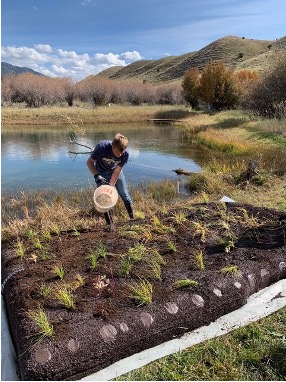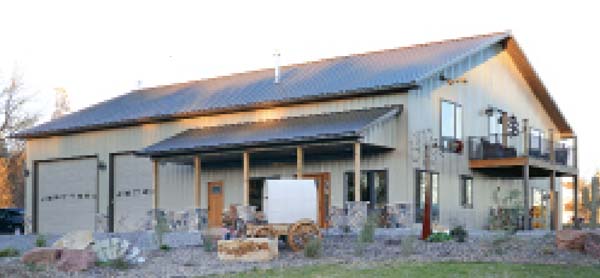By Jacob Prater
Do you have a pond or wetland on your property (or a client that does) that is impacted by nutrient runoff? Managing water quality in and around agriculture can be a real challenge. The necessary use of fertilizers and manures to optimize crop production presents a very real impact on ponds, lakes, and wetlands on the farm. Even with the best runoff and erosion management being employed by America’s top-notch crop and livestock producers there still is a need to remove some excess nutrients from ponds, lakes, and wetlands on and around farms today. A new and innovative way to do that is to start using the pond or lake as a water and nutrient supply for plants on a floating island. The plants growing on your floating island will take up nutrients from your pond and can be removed each time you cut back or replace those plants. A floating island can also bring you many other side benefits depending on how you use and design it.
Georgia Web, located in Wrens, Georgia, is making a product that can be used to create these floating islands for a variety of applications. They are leveraging their years of experience in creating air-lay non-woven products such as roofing ridge vent material to create an industry leading product for floating islands and erosion control. “Georgia Web’s product is unique in its uniformity (density and thickness) and in its ability to stand up to ultraviolet radiation and other weather impacts”, says Wylie Prescott. “We can make this Floating Island Matrix in any thickness from 1-3 inches, but most of what we produce right now is 1¾ inch thick material.”
Floating Island Matrix material is currently available in 60 or 80 inch widths in sheets or rolls and can be stacked to achieve greater thicknesses and floatation depending on your needs. Applications for this type of product range from erosion control (applying the product to the ground) to nutrient and water quality clean up (floating islands) in ponds, lakes, and wetlands, but the utility only starts there! Floating islands can be used as duck blinds and waterfowl habitat, gardens, and anything else you can dream up. Essentially you can add beauty and utility to your water body while at the same time improving the water quality.
Using plants to take up excess nutrients from water is the cornerstone of a production system where crops are grown without soil. These hydroponic systems can be highly productive as they supply all the needed water that might normally limit plant growth in a field or garden. The downside to typical hydroponic systems is the infrastructure and investment to build and maintain them.
A floating island, however, can be very simple to build and takes advantage of the same ideas and productive capacity as hydroponics. With the water supply readily available (your pond, lake, or wetland) and the necessary nutrients already in your pond (even if you don’t want them there), all that remains is to build the floating island to whatever specifications you see fit. What we have here then is a win-win situation.
Not only can these floating islands help clean up your pond, but they can also help you grow food, feed, or compostable plant material for use on your land. They also may enhance the fishery in your pond with cover and protection for both small and large fish.

Building one of these floating islands does require a quality and long-lasting substrate for the plants to anchor themselves in and grow. Here is where Georgia Web has you covered with a product that will stand up to the elements for 15+ years of continuous use. This durability makes it worth the investment to install a floating island in your pond or wetland to get the benefits you want. Beyond the product durability, Georgia Web is using recycled polyester materials to construct the Floating Island Matrix material and has had their product tested to ensure that it is free of harmful chemicals or effects on your water life. With this confidence in green material sourcing and safe tested material you can set about cleaning up your pond or wetland and enhancing its beauty and function.
Floating island design parameters, such as size, plant selection, and material thickness depend on the intended use and current water quality of the pond or wetland. Support for determining what you need for your island design can be found from Martin Ecosystems and other floating island builders that Georgia Web can put you in touch with.
Once you have designed and built your floating island the plants you use can be cut-back or removed and replaced as determined, as this is the major method of getting the nutrients out of the water in your pond. This is a critical point to consider in your design. The strength of the Floating Island Matrix product here is in its light weight, strength, and durability. You can create modular islands and easily pull them ashore to harvest your plants after which you simply put your floating island back out into the water to keep growing and cleaning up your water.
Georgia Web is manufacturing their product in the USA and shipping it worldwide for a variety of uses with floating islands being a new and exciting application. Being one of two domestic suppliers for a similar product, Georgia Web’s Floating Island Matrix is the product of choice right now for those wanting to construct floating islands due to its uniformity in production and its durability in practice and use. The Floating Island Matrix material has also been used to capture sediment in flowing water, reduce the impacts of wave action on shorelines, and provide erosion control and bank stabilization.
If you have other ideas for use or want a custom product feel free to contact Wylie Prescott [email protected] for more information.




















